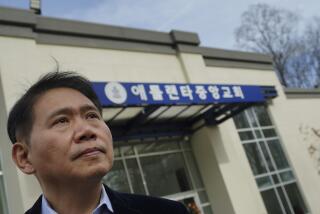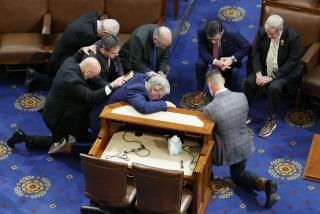South Korea churches’ beacons an eyesore to some
For a quarter of a century, Kim Un-tae has found comfort in the red neon cross that sits atop the steeple of the Protestant church he founded here.
For the 70-year-old holy man, the soft glow of the religious icon has always signified that his faith was open for anyone willing to enter the doors of his church. “It’s like a coastal lighthouse for passing ships in the dark,” Kim said.
Yet critics say church crosses like Kim’s are just another form of light pollution.
Tens of thousands of churches dot South Korea, most with their own red neon crosses. In Seoul, where several churches crowd onto a single block, illuminating their crosses until midnight or later, the beacons combine to color the urban night like a carnival come to town.
“Looking from above, the night scene of Seoul looks like that of a graveyard,” one Internet user complained in a posting.
The glare of neon lights atop restaurants, motels and retail stores has become such a blight that legislators this year passed a law to limit what they called “excessive illumination from artificial light.”
Park Young-ah, a lawmaker with the ruling Grand National Party, worried about the long-term health effects of such glare. “Systematic control of light pollution and standards for the appropriate level of light do not exist,” she wrote in her bill proposal.
Churches were originally included in the legislation, but massive protests and lobbying efforts staged by numerous church councils made politicians back down.
“We really didn’t expect the religious groups to interpret the bill to be anti-Christian and react like this,” said Park’s spokesman, Noh Chang-hoon.
Kim Un-tae insists that any effort to dim the night crosses is a “foolish” attack on religious freedom. Because the mission of the church goes beyond the pursuit of capital gain, their leaders should not be subjected to a blanket government law, he reasoned.
“We don’t like to use the word exception, but yes, we do believe that one should be made,” said Kim, who years ago left his church to become director of the Christian Council of Korea, which represents 50,000 churches nationwide.
Still, critics say the churches are ignoring neighbors who struggle to sleep with the red neon lights shining through their bedroom windows. “Honestly, I don’t believe the brighter the cross, the closer we get to God,” one Seoul official told the local JoongAng Daily newspaper, requesting anonymity.
A 2005 government study showed that nearly half of South Koreans express no religious preference, 23% are Buddhist, 20% are Protestant, and 11% are Catholic.
South Korea’s churches originally had tolling bells to attract worshipers, but most eventually changed to neon crosses, usually red, to signify the blood of Christ, officials say.
The propensity of the crosses moved photographic artist Cha Zoo-young this year to document the spread of the icons. He took thousands of pictures of South Korean urban landscapes, many filled with competing red crosses. His public showing of his work, criticized by churches, was meant to “talk about the fact that we should not blindly follow religion,” he said.
One blogger who calls himself Cha documented his own battle with church officials who refuse to dim their cross. “It’s so much like daytime at night that I’m chronically sleep-deprived,” he wrote.
But complaints by residents of his apartment building have failed. City officials say all they can do is make suggestions to the church. The cross is now extinguished at 11:30 p.m., half an hour earlier, but it is switched on again at 4 a.m.
Others find solace in the crosses. “This is a poor community, but people here have hope,” said one real estate agent. “Those crosses are a symbol of that hope.”
Park Sun-ung, the minister of a 50-member rural congregation a few hours outside Seoul, may have stumbled upon a solution to the light controversy.
A few years ago, Park — who also works as a farmer — noticed the red neon cross atop his house-sized church continued to go out. He soon discovered that a nest of magpies had shorted the circuit.
After consulting with church leaders, he decided to leave the cross dark in favor of the birds’ habitat. “We agreed that our church was a place to save lives, even those of other creatures,” Park said.
Now his cross sits dark among the town’s dozen other beacons. The pastor believes that other churches might follow suit, replacing their neon crosses with perhaps a less-intrusive sculpture.
“It distances our church from the others,” Park said. “We stand out because we don’t have a light.”
Jung-yoon Choi of The Times’ Seoul bureau contributed to this report.
More to Read
Start your day right
Sign up for Essential California for news, features and recommendations from the L.A. Times and beyond in your inbox six days a week.
You may occasionally receive promotional content from the Los Angeles Times.







